Imagine yourself, if you can, waking up African American in the United States today. Imagine having to decide — in any city or town or rural community in any part of the country — that you and your family can safely step outside your front door. Or, for that matter, that you and they can safely stay at home. Imagine pondering whether the time has come for you to start taking lessons at the local shooting range and get yourself a gun.
I find that easier to imagine than you might think, because I’m half-Jewish. On my father’s side, which makes me not truly Jewish according to the truly Orthodox (who require matrilineal descent) but certainly Jewish enough for the anti-Semites. Of which we have no shortage in this country, according to the cornucopia of evidence now spread before us. With more to come, surely; as my late friend Richard Kirstel used to say, “Scratch a good American and you’ll find a good German.” So, over the past months, I have imagined all of those options I listed in my opening paragraph — including, to my consternation, the acquisition of firearms.
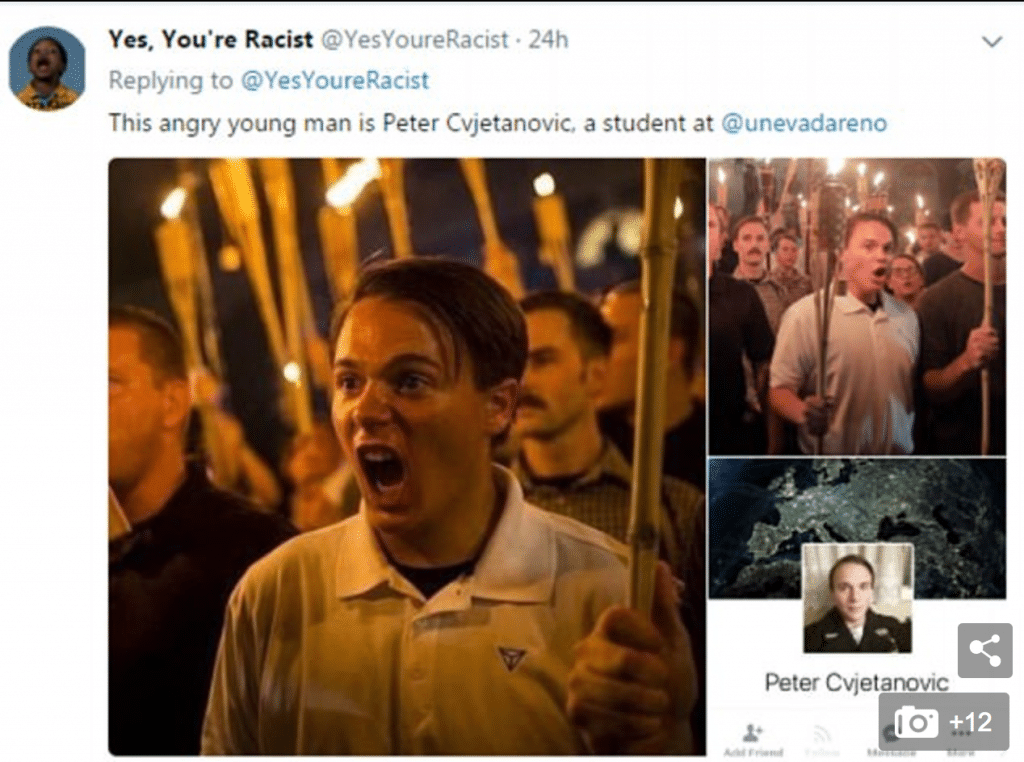
“Good American” Peter Cvjetanovic, Charlottesville, VA, August 11, 2017. Screenshot from @YesYoureRacist.
The hackles of anyone who treasures living in a democracy should rise when armed goon squads carrying Confederate flags and Nazi banners march and throw Nazi salutes in public anywhere, especially in their shared homeland. But while anti-Semitism constitutes a subset of the larger evil we call racism, it remains a particularly virulent version thereof, arguably the oldest and most enduring. So when those thugs with torches chant “Sieg Heil” and “Jews will not replace us,” then yes, I take it very, very personally. Because, I remind you, as Pastor Martin Niemöller wrote, “… Then they came for the Jews …”
Well, as the written reports — and, more undeniably, and with even more visceral impact, the accompanying still and video images — prove, they have started to come for the Jews. So much for the babble about post-racialism. This is what virulent anti-Semitism looks like, unabashedly showing its true face en masse at long last.
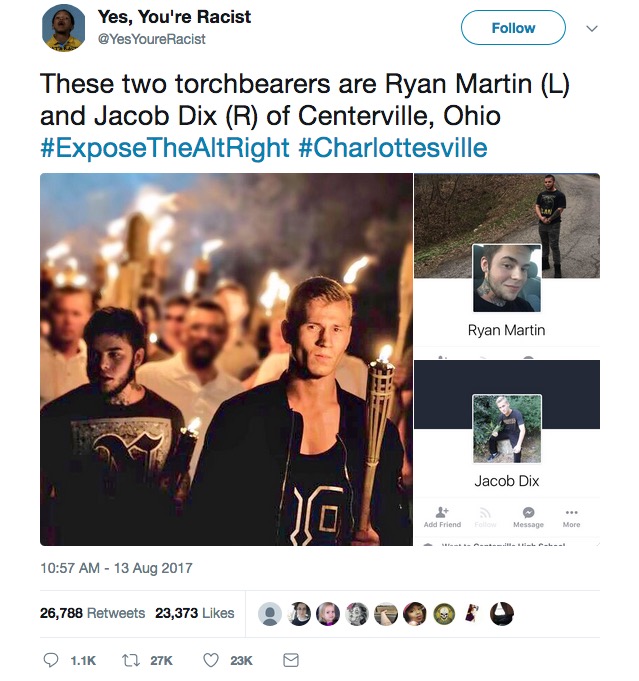
“Good Americans” Ryan Martin (L) and Jacob Dix (R), Charlottesville, VA, August 11, 2017. Screenshot from @YesYoureRacist.
Unlike our unpresident, who adores and enables these “blood and soil” fascists because they adore and enable him, I don’t flinch from calling this by its rightful name: radical Christian terrorism. Christianity has no monopoly on anti-Semitism, of course, but it’s safe to say that the neofascist mob descending on Charlottesville, Va. last weekend didn’t include many Muslims. Avowedly and unequivocally, the Charlottesville “Unite the Right” rally constituted a white Christian show of force, and Christians of all stripes need to recognize, and acknowledge, and own it, and deal with it as such.
That surely includes Christian evangelicals, among them the smattering of beaming African American ministers who, along with their melanin-deficient counterparts, crowded into the Oval Office on July 12, just over a month ago, to pray with and bless Donald Trump. For anyone who believes that the separation of church and state constitutes the bedrock of democracy, this is a deeply frightening photograph:
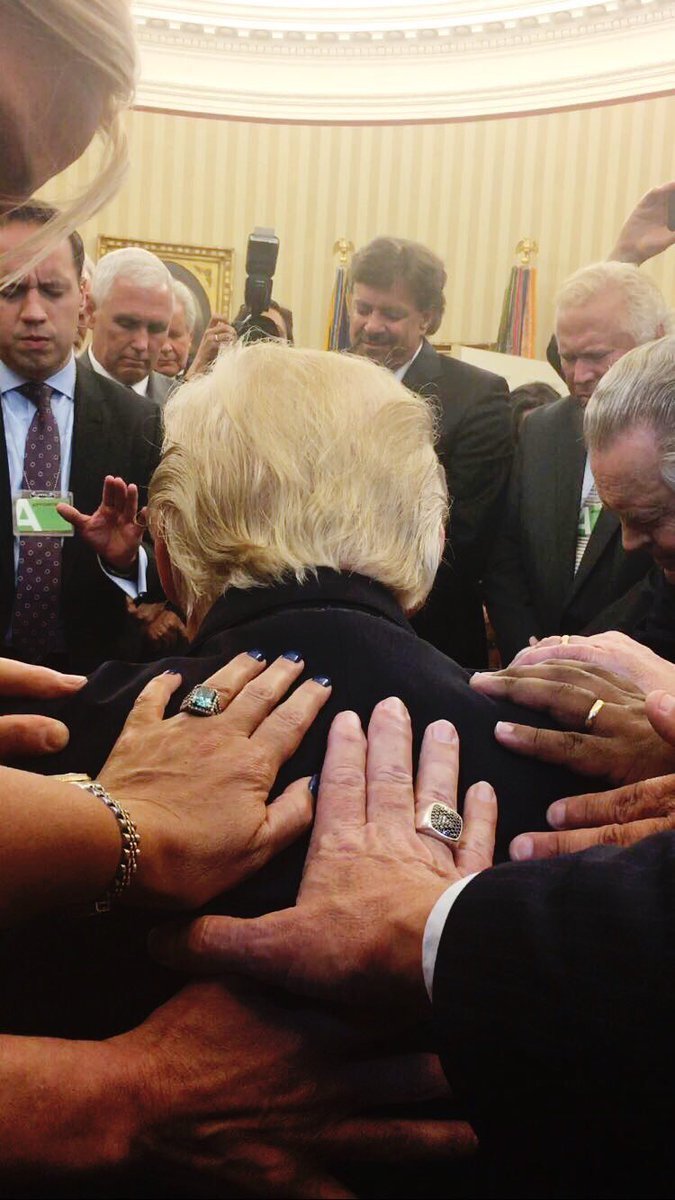
Donald Trump, Mike Pence, Michele Bachmann praying with evangelicals in the Oval Office, July 10, 2017. Photo by Johnnie Moore.
These proud Christians — among them Veep Mike Pence, Johnnie Moore (former senior vice president at Liberty University), Jack Graham (pastor of Prestonwood Baptist Church in Plano, Texas), and Michele Bachmann (former Republican congresswoman from Minnesota) — now face a hard choice: Do they stand by the amoral, sociopathic demagogue they worked so hard to elect, because he has given them so much of what they want, or do they abandon or even denounce him for his unholy alliance with the neofascists?
Whatever their decisions, as Wendy Luxenburg writes, “Dear America, it’s time to stop pretending.” Though she doesn’t mention it in her otherwise eloquent polemic, those storm troopers came to Charlottesville bent on protecting a monument to a treasonous, devoutly Christian slave-owner who lost a war intended to divide the United States and perpetuate race-based human bondage for profit. They represent one true face — and, right now, the most prominent face — of Christianity in this country.
Here’s the really scary part: They’re good Christians, all of them. Scratch a good Christian, and you’ll find a good American. Scratch a good American …
Exceptions Proving the Rule
Donald Trump, who most likely has never actively contemplated a Confederate memorial in his life, has chosen this moment to mourn in advance the disappearance of these “beautiful statues and monuments” from our public sphere. However, saner heads prevail. Many people — including Trump, obviously — don’t know that Robert E. Lee opposed not only monuments to the Confederacy but the flying of the Confederate flag after the South’s defeat and surrender. So does Robert E. Lee V, one of the general’s descendants, who suggested that such artifacts belong in a museum.
Ironically, given the blatantly unchristian behavior of the racist swarm that invaded Charlottesville, several of Confederate General Thomas “Stonewall” Jackson’s descendants — surnamed Christian — have called for the removal of statues of their forebear. In direct response to the events in Charlottesville, and discussions elsewhere about Confederate memorials, Jack and Warren Christian wrote in an open letter to the mayor of Richmond, Va, published by Slate,
“[Such monuments] were constructed to be markers of white supremacy. They were constructed to make black people fearful. I can only imagine what persons of color who have to walk and drive by those every morning think and feel. …
“While we are not ashamed of our great-great-grandfather, we are ashamed to benefit from white supremacy while our black family and friends suffer. We are ashamed of the monument.”
For a description of how heroic general and good Christian Robert E. Lee treated his own slaves, click here. Spoiler alert: I especially like the part about him ordering his slaves’ lacerated backs washed with brine after their whippings.
The Neofascists’ Heinrich Hoffmann
Having argued, through the past two presidential election cycles, that the left far surpasses the right in the sophistication of its visual image-making and image usage, it comes as no surprise that someone on the neofascist end of the spectrum has decided to catch up on that front.
In “The Annie Leibovitz of the Alt-Right,” by Matthew Kassel, New York Times, July 20, 2017, the reporter profiles one Peter Duke, a 60-year-old Los Angeles-based former fashion photographer who has decided that such prominent radical-right figures as Charles Johnson, Mike Cernovich, Milo Yiannopoulos, Andrew Breitbart, and Malik Obama deserve more sophisticated portraiture than they’ve received to date. Kassel writes,
“I got a wild hair up my ass,” Duke told me, “and I said, ‘I want to start taking pictures of our side and making our side look heroic.'”
![]() Kassel’s article handles this charged material with traditional journalistic “objectivity,” taking a neutral reportorial position and letting his subject — and some of his subject’s subjects — speak for themselves. I’m not alone in having my reservations about that journalistic posture. (See my series on Thomas E. Patterson’s Informing the News: The Need for Knowledge-Based Journalism.) Neutrality always favors the status quo, especially when, as in Kassel’s case, he provides no contrary take on Duke’s project, thus implicitly endorsing it himself while also putting the imprimatur of the New York Times on it.
Kassel’s article handles this charged material with traditional journalistic “objectivity,” taking a neutral reportorial position and letting his subject — and some of his subject’s subjects — speak for themselves. I’m not alone in having my reservations about that journalistic posture. (See my series on Thomas E. Patterson’s Informing the News: The Need for Knowledge-Based Journalism.) Neutrality always favors the status quo, especially when, as in Kassel’s case, he provides no contrary take on Duke’s project, thus implicitly endorsing it himself while also putting the imprimatur of the New York Times on it.
The icing on this cake, however, comes in the form of this article’s headline, almost surely not written by Kassel himself: “The Annie Leibovitz of the Alt-Right.” That phrase appears nowhere in Kassel’s piece. Because neofascism notoriously and forthrightly trends anti-Semitic, while Leibovitz is of Jewish descent, this headline either deliberately sets out to offend both of those constituencies or (more likely) demonstrates the cluelessness of this headline’s author and the editor who approved it for publication.
Heinrich Hoffmann or Leni Riefenstahl would have served more aptly as an exemplar of Duke’s lineage.
•
Speaking of Annie Leibovitz:
Someone — and absolutely no one involved seems ready to say who — came up with an idea in 2012 for a patron to purchase 2,070 photos by the American portrait photographer Annie Leibovitz and then donate them to a museum in Canada.
This was a colossal score for the Art Gallery of Nova Scotia in Halifax, which owned nothing by Ms. Leibovitz at the time.
For Ms. Leibovitz, who had a financial crisis several years earlier, the transaction meant she earned several million dollars.
And the donor, a Deloitte Canada partner [Harley Mintz] who said he had bought the collection to honor his mother’s memory, stood to qualify for a generous tax deduction and recognition as an arts patron.
Four years later, though, a Canadian government panel that must sign off on the deduction is still balking at approving it, partly because the panel won’t accept a $20 million valuation for a collection that the donor purchased for just $4.75 million.
Why a remote Nova Scotia museum coveted a massive selection of pop-culture imagery by the Connecticut-born celebrity photographer, who has no connection whatsoever to Canada (nor to Maine, off whose border the island peninsula that includes Halifax sits), remains a mystery. For details, see the July 25, 2017 New York Times article by Sopan Deb and Colin Moynihan, “Canada Debates Whether Gift of Leibovitz Photos Is Also a Tax Dodge.”
Crafting the Trumpian Image
Shealah Craighead, President Donald Trump’s Chief Official White House Photographer, seems cut from the same cloth as Peter Duke, specializing in flattering imagery of right-wing figures, though most of them more highly placed in the Republican ranks than (and few as extreme as) Duke’s pantheon.

President-elect Donald Trump walks to take his seat for the inaugural swearing-in ceremony at the U.S. Capitol in Washington, D.C., Friday, Jan. 20, 2017. Official White House Photo by Shealah Craighead.
Craighead appears to accept without complaint the restrictions placed on her by the Trump administration, a radical departure from the much more open access granted by his predecessor, Pres. Barack Obama, to his official photographer, Pete Souza. For an informative interview with Craighead, see Elizabeth Flock’s “What it’s like to be President Trump’s White House photographer,” which appeared in PBS Newshour’s “Art Beat” on August 7, 2017.
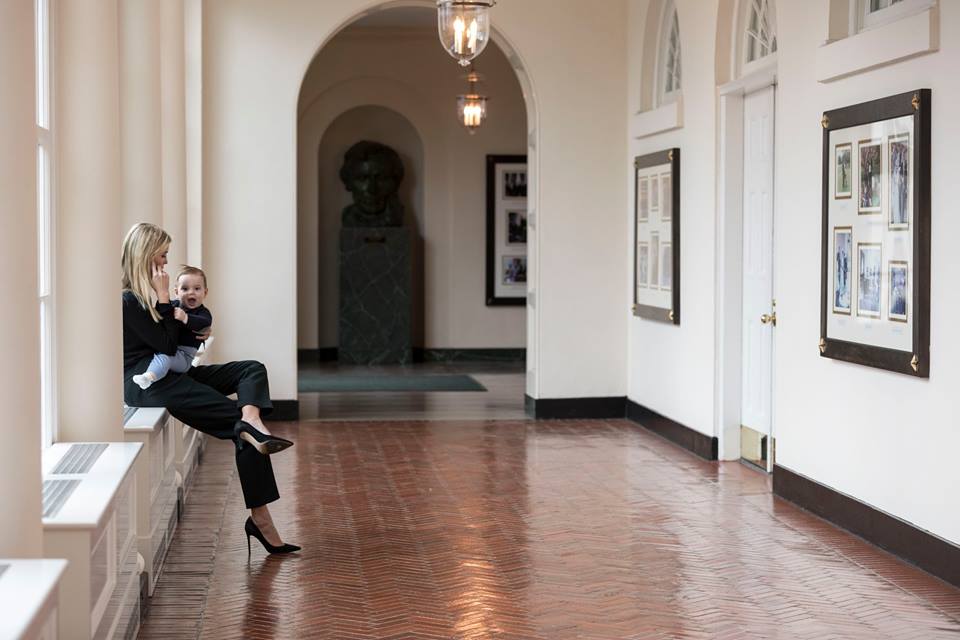
Holding her youngest son Theodore, Ivanka Trump talks on the phone in the East Colonnade of the White House, Sunday, Jan. 29, 2017. (Official White House Photo by Shealah Craighead)
•
This post sponsored by a donation from David Wunsch.
•
 Special offer: If you want me to either continue pursuing a particular subject or give you a break and (for one post) write on a topic — my choice — other than the current main story, make a donation of $50 via the PayPal widget below, indicating your preference in a note accompanying your donation. I’ll credit you as that new post’s sponsor, and link to a website of your choosing. Include a note with your snail-mail address (or email it to me separately) for a free signed copy of my 1995 book Critical Focus!
Special offer: If you want me to either continue pursuing a particular subject or give you a break and (for one post) write on a topic — my choice — other than the current main story, make a donation of $50 via the PayPal widget below, indicating your preference in a note accompanying your donation. I’ll credit you as that new post’s sponsor, and link to a website of your choosing. Include a note with your snail-mail address (or email it to me separately) for a free signed copy of my 1995 book Critical Focus!
 But wait! There’s more! Donate now and I’ll include a copy of The Silent Strength of Liu Xia, the catalog of the 2012-13 touring exhibition of photos by the dissident Chinese photographer, artist, and poet, currently in her sixth year of extralegal house arrest in Beijing. The only publication of her photographic work, it includes all 26 images in the exhibition, plus another 14 from the same series, along with essays by Guy Sorman, Andrew Nathan, and Cui Weiping, professor at the Beijing Film Academy.
But wait! There’s more! Donate now and I’ll include a copy of The Silent Strength of Liu Xia, the catalog of the 2012-13 touring exhibition of photos by the dissident Chinese photographer, artist, and poet, currently in her sixth year of extralegal house arrest in Beijing. The only publication of her photographic work, it includes all 26 images in the exhibition, plus another 14 from the same series, along with essays by Guy Sorman, Andrew Nathan, and Cui Weiping, professor at the Beijing Film Academy.



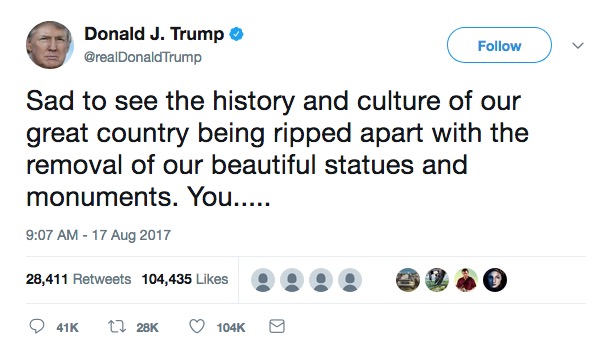




[Ahem] Unlike Staten Island, Nova Scotia is neither remote nor an island!
Nick, in Boston, MA
My mistake; Nova Scotia is a peninsula, not an island. Thanks for pointing that out. I’ve made the correction in the article above.
As for my calling this excellent museum “remote”: It’s 15 hours by car from New York City, 14 hours from Ottawa, 12 hours from Montreal, and 10 hours from Quebec City. Readers can make their own determinations concerning its accessibility here at Google Maps, which offers these “Quick facts”:
Nova Scotia is one of eastern Canada’s Maritime provinces on the Atlantic. Consisting of a peninsula and offshore islands, it’s home to puffins and seals, and popular for water sports like kayaking. The Bay of Fundy, with its famously extreme tides, is a whale-watching destination. Halifax, the capital, dominated by the star-shaped Citadel, is known for its lively waterfront and Victorian-era Public Gardens.
Sounds lovely, and no doubt there are people who do not find it remote. But they probably live much closer to it than I do.
I bet many of those eager to tear down statues that are historical records be the same people who were mad at Taliban fighers in Afghanistan who destroyed centuries old historical cliff carvings?
One does not have to agree with the beliefs and practices of those whose statues and memorials they see. These things are history and should be preserved, not changed with politically insane whims every few years.
How long before book burning and greater censorship shows its ugly head?
You omit one crucial fact: No one has demanded the destruction of the statues and monuments in question. Your equation of those who argue for their displacement with the Taliban is thus specious on its face.
Those who oppose the continuing prominent presence of these racist symbols in prestigious public locations where the citizenry circulates daily have raised no objections to their relocation to museums or other repositories where people can choose to visit and view them (or not), and where their meaning and history can be contextualized instructively.
That’s exactly what happened in Germany and Italy after the end of World War II. The winning side removed visible traces of the self-glorification of odious, defeated regimes.
Indeed, the U.S. stands perhaps alone in its prolonged tolerance of such celebrations of the traitors on the losing side of an insurrection that would have destroyed the country — and that was, by any rational assessment, on the wrong side of history. Not to mention the fact that these physical hymns of praise to the “Lost Cause” sprang from — and thus represent — historical moments when racist white Southerners felt the need to reassert their power over emancipated but still oppressed African Americans by erecting these threatening reminders.
What rationale other than racism can justify the original placement of a larger-than-life statue of Supreme Court judge and segregationist Roger Taney on the front lawn of the Maryland State House? Taney authored the 1857 SCOTUS Dred Scott decision ruling that African Americans could never deserve citizenship? What rationale other than racism can justify keeping it in place today, when that decision, which wrought so much damage for so long, is widely considered the worst Supreme Court decision in history?
Proclaiming the present long-overdue reconsideration of the appropriateness of maintaining such artifacts in the public sphere as some form of censorship does not serve you well.
Those that argue that by destroying these statues we are destroying our history and our understanding of it are dead wrong. There are no statues of Hitler, Goebbels, Goering etc in Germany and yet Germans have an acute sense and knowledge of their own history.